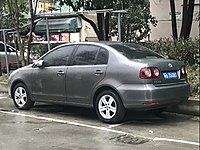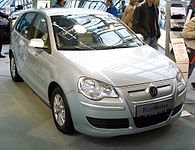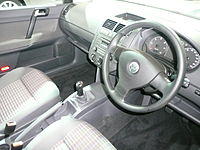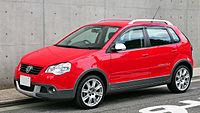Volkswagen Polo Mk4
| Volkswagen Polo Mk4 (9N) | |
|---|---|
 | |
| Overview | |
| Manufacturer | Volkswagen |
| Also called | Volkswagen Polo Vivo |
| Production | 2001–April 2010 (Germany) 2002–2014 (Brazil) 2002–2017 (South Africa) |
| Assembly | Germany: Wolfsburg Spain: Pamplona Belgium: Brussels Slovakia: Bratislava[1] Brazil: Sao Bernardo do Campo[2] South Africa: Uitenhage China: Anting (SAIC-VW) Angola: Luanda (Ancar) Kenya: Thika (KVM = Kenya Vehicle Manufacturers, Polo Vivo) |
| Body and chassis | |
| Class | Supermini (B) |
| Body style | 3-door hatchback 5-door hatchback 4-door sedan |
| Layout | Front-engine, front-wheel-drive |
| Platform | Volkswagen Group A04 (PQ24) |
| Related | SEAT Ibiza Mk3 SEAT Córdoba Mk2 Škoda Fabia Mk1 Škoda Fabia Mk2 Škoda Roomster Volkswagen Fox |
| Powertrain | |
| Engine | 1.2 L I3 (petrol) 1.4 L I4 (petrol) 1.6 L I4 (petrol) 1.8 L I4 (t/c petrol) 2.0 L I4 (petrol) 1.4 L I3 (t/c diesel) 1.9 L I4 (diesel) 1.9 L I4 (t/c diesel) |
| Transmission | 5-speed manual 6-speed manual 4-speed automatic 6-speed automatic |
| Dimensions | |
| Wheelbase | Sedan: 2,465 mm (97.0 in) 2002–07 3-door: 2,460 mm (96.9 in) 2008–09 5-door: 2,454 mm (96.6 in) |
| Length | Sedan: 4,198 mm (165.3 in) 2002–04 5-door: 3,897 mm (153.4 in) 2005–07 5-door: 3,926 mm (154.6 in) 2008–09 5-door: 3,916 mm (154.2 in) |
| Width | 1,650 mm (65.0 in) |
| Height | Sedan: 1,501 mm (59.1 in) 2002–07 Hatchbacks: 1,465 mm (57.7 in) 2008–09 5-door: 1,467 mm (57.8 in) 2008–09 3-door: 1,452 mm (57.2 in) |
| Chronology | |
| Predecessor | Volkswagen Polo Mk3 |
| Successor | Volkswagen Polo Mk5 |
The Volkswagen Polo Mk4 is the fourth generation of the Volkswagen Polo supermini car produced by the German manufacturer Volkswagen. It was marketed from early 2002 to 2010 in most countries except Argentina and the USA. It was manufactured in South Africa until 2017, it was sold as the Polo Vivo.[3] The Mk4 replaced the Volkswagen Polo Mk3, while the Polo Vivo replaced the Citi Golf. In 2018 the Mk4 was replaced by the Volkswagen Polo Mk5 Polo Vivo. In Brazil, It was manufactured until 2014 with a second facelift called 9n4, It was replaced in 2017 by Volkswagen Polo Mk6.
Overview

Launched in September 2001 at the Frankfurt Motor Show,[4] the fourth generation Polo (internal designation Typ 9N) was made available in early 2002.[citation needed] In keeping with Volkswagen's aim of floor pan sharing it shares its platform with the SEAT Ibiza 6L, SEAT Córdoba 6L, Volkswagen Gol Third Generation, also called G5 or N.F.- Not to be confused with Volkswagen Golf - and Škoda Fabia Mk1. The car is all new, and bears more structural resemblance to the 6K than the 6N,[citation needed] outwardly the most recognizable change is the quad round headlights similar to the Volkswagen Lupo.
At a length of over 3,900 mm (153.5 in), the South African-built Polo Vivo is longer than the first generation of its larger sibling, the Volkswagen Golf Mk1, 3,820 mm (150.4 in) in length.
Release in North America

In January 2009, Volkswagen Group of America CEO Stefan Jacoby announced that the Polo will finally reach North America to join the vehicle line-up as a true entry-level car below the Rabbit. However, the Polo Mk4 was never released in the North American market, leaving the speculation for its successor, the Polo Mk5. When the Mk5 was introduced in European markets, it was not made available for US sale. Due to the increased demand for SUVs, VWoA management confirmed the Mk5 was not slated for a US introduction in the foreseeable future. If the Mk5 had been introduced in the US, it was anticipated to be built at Volkswagen's plant in Puebla, Mexico, alongside the Jetta and New Beetle. As of 2016, there are still no plans to introduce the Polo Mk5 or future generations of the Polo in the US.[5]
Models and specifications
The model range includes the norm for current Volkswagen models, from the Comfortline to the Trendline and Highline, whilst featuring an extensive list of extras that had now become norm in mid-sized small cars. Items such as ABS, power steering, front and side airbags and front and rear head restraints were standard on all models and ESP, brake assistance, air conditioning, satellite navigation etc. were optional on higher spec models.
It is the first Polo generation to use a semi-automatic air conditioning system, with automatic climate control, named Climatic, that adjusts the interior temperature automatically to the value set on the control panel, whereas the air distribution and air blower speed are adjusted manually. A fully automatic air conditioning system, named Climatronic, was also offered.[6]
It was available with a choice of a five-speed manual gearbox, a six-speed manual gearbox, only for the sporty 1.9-litre 130 PS (96 kW) diesel model, or with a four-speed automatic gearbox, used only in combination with the 1.4-litre 75 PS (55 kW) petrol engine.[6] A six-speed semi-automatic transmission (Tiptronic) was added from mid-2006, after the facelift, also available only with the 1.4-litre 80 PS (59 kW) or with the 1.6-litre 105 PS (77 kW) petrol engines.[7]
There was also a crossover version of the Polo, with off-road styling, named Polo Fun (Polo Dune in the UK, Polo Soho in Spain, CrossPolo in South Africa), released in 2003 - despite its appearance the car was never available with 4WD.
Engines
The Polo was available with several petrol and diesel engines: a 1.2 L three-cylinder petrol engine with 55 PS (40 kW; 54 hp) or 64 PS (47 kW; 63 hp) (depending on the number of valves per cylinder, two or four) and a 16-valve 1.4 L 4-cylinder with 75 PS (55 kW; 74 hp) or 100 PS (74 kW; 99 hp) petrol engine, the last one on the 16V-badged model.
Both turbocharged and unturbocharged diesel engines were available such as the 4-cylinder 1.9 L SDI (Suction Diesel Injection) which also offered 64 PS (47 kW; 63 hp) but with 125 N⋅m (92 lb⋅ft) of torque, slightly more than some petrol powered units. As well as the unturbocharged SDI engine, newer TDI PD turbodiesel units were also available, these being a 1.9 L with 100 PS (74 kW; 99 hp) and a three-cylinder 1.4 L model (the 1.9 with one cylinder less) with 75 PS (55 kW; 74 hp). A sporty 1.9 TDI PD model, named Polo GT, was launched in 2004, with 130 PS (96 kW; 128 hp).
| Petrol engines | |||||||
|---|---|---|---|---|---|---|---|
| Engine | Code | Type | Displacement | Power (Max output) | Torque (Max output) | Years | Top speed |
| 1.2 | AWY / BMD | I3 SOHC 6V, multi-point sequential fuel injection | 1198 cc | 55 PS (40 kW; 54 hp) at 4750 rpm | 108 N⋅m (80 lb⋅ft) at 3000 rpm | 2001–2007 | 152 km/h |
| 1.2 | BBM | I3 SOHC 6V, multi-point sequential fuel injection | 1198 cc | 60 PS (44 kW; 59 hp) at 5200 rpm | 108 N⋅m (80 lb⋅ft) at 3000 rpm | 2007–2009 | 157 km/h |
| 1.2 | AZQ / BME | I3 DOHC 12V, multi-point sequential fuel injection | 1198 cc | 64 PS (47 kW; 63 hp) at 5400 rpm | 112 N⋅m (83 lb⋅ft) at 3000 rpm | 2001–2007 | 162 km/h |
| 1.2 | BZG | I3 DOHC 12V, multi-point sequential fuel injection | 1198 cc | 70 PS (51 kW; 69 hp) at 5400 rpm | 112 N⋅m (83 lb⋅ft) at 3000 rpm | 2007–2009 | 167 km/h |
| 1.4 | AUA / BBY / BKY | I4 DOHC 16V, multi-point sequential fuel injection | 1390 cc | 75 PS (55 kW; 74 hp) at 5000 rpm | 126 N⋅m (93 lb⋅ft) at 3800 rpm | 2001–2007 | 172 km/h |
| 1.4 | BUD | I4 DOHC 16V, multi-point sequential fuel injection | 1390 cc | 80 PS (59 kW; 79 hp) at 5000 rpm | 132 N⋅m (97 lb⋅ft) at 3800 rpm | 2007–2009 | 175 km/h |
| 1.4 FSI | AXU | I4 DOHC 16V, Fuel Stratified Injection | 1390 cc | 86 PS (63 kW; 85 hp) at 5000 rpm | 130 N⋅m (96 lb⋅ft) at 3750 rpm | 2002–2006 | 178 km/h |
| 1.4 | AUB / BBZ | I4 DOHC 16V, multi-point sequential fuel injection | 1390 cc | 101 PS (74 kW; 100 hp) at 6000 rpm | 126 N⋅m (93 lb⋅ft) at 4400 rpm | 2002–2006 | 188 km/h |
| 1.6 | BTS | I4 DOHC 16V, multi-point sequential fuel injection | 1598 cc | 105 PS (77 kW; 104 hp) at 5600 rpm | 153 N⋅m (113 lb⋅ft) at 3800 rpm | 2006–2009 | 192 km/h |
| 1.8T GTI | BJX | I4 DOHC 20V, multi-point sequential fuel injection and turbocharger | 1781 cc | 150 PS (110 kW; 150 hp) at 5800 rpm | 220 N⋅m (160 lb⋅ft) at 1900–4500 rpm | 2006–2009 | 216 km/h |
| 1.8T GTI Cup Edition | BBU | I4 DOHC 20V, multi-point sequential fuel injection and turbocharger | 1781 cc | 180 PS (130 kW; 180 hp) at 5800 rpm | 235 N⋅m (173 lb⋅ft) at 2000–5000 rpm | 2006–2009 | 225 km/h |
| Diesel engines | |||||||
|---|---|---|---|---|---|---|---|
| Engine | Code | Type | Displacement | Power (Max output) | Torque (Max output) | Years | Top speed |
| 1.4 TDI | BNM / BWB | I3 SOHC 6V, Pumpe Düse (PD) injectors; optional diesel particulate filter (DPF) | 1422 cc | 70 PS (51 kW; 69 hp) at 4000 rpm | 155 N⋅m (114 lb⋅ft) at 1600–2800 rpm | 2005–2009 | 164 km/h |
| 1.4 TDI | AMF / BAY | I3 SOHC 6V, Pumpe Düse (PD) injectors | 1422 cc | 75 PS (55 kW; 74 hp) at 4000 rpm | 195 N⋅m (144 lb⋅ft) at 2200 rpm | 2001–2005 | 170 km/h |
| 1.4 TDI | BNV / BMS | I3 SOHC 6V, Pumpe Düse (PD) injectors; optional diesel particulate filter (DPF) | 1422 cc | 80 PS (59 kW; 79 hp) at 4000 rpm | 195 N⋅m (144 lb⋅ft) at 2200 rpm | 2005–2009 | 174 km/h |
| 1.9 SDI | ASY | I4 SOHC 8V, distributor-type injection pump | 1896 cc | 64 PS (47 kW; 63 hp) at 4000 rpm | 125 N⋅m (92 lb⋅ft) at 1600–2800 rpm | 2001–2005 | 160 km/h |
| 1.9 TDI | ATD / AXR / BMT | I4 SOHC 8V, Pumpe Düse (PD) injectors; optional diesel particulate filter (DPF) | 1896 cc | 101 PS (74 kW; 100 hp) at 4000 rpm | 240 N⋅m (180 lb⋅ft) at 1800–2400 rpm | 2001–2009 | 188 km/h |
| 1.9 TDI | ASZ / BLT | I4 SOHC 8V, Pumpe Düse (PD) injectors | 1896 cc | 130 PS (96 kW; 130 hp) at 4000 rpm | 310 N⋅m (230 lb⋅ft) at 1900 rpm | 2003–2009 | 206 km/h |
Sedan
A sedan version was launched in November 2003.[8] It was produced in Brazil, South Africa and China and exported to the rest of Latin America and Australia, as well as to Europe. With the introduction of the Polo Classic saloon in the Australian market in 2004, the Chinese version, has the distinction of being the first Chinese-built car to be produced in right-hand drive.[9]
Compared to the hatchback model, the Polo Sedan (also "Saloon" or "Limousine") is completely re-styled from the B-pillar rearwards. The window line has a slight upward incline and the roof features Volkswagen’s trademark curves and the concise styling of the C-pillar provides aspects that are actually reminiscent of a coupe. At the rear, the large horizontally divided rear lights and sculptured panels complete a design that is classically Volkswagen.
Overall, the Polo Sedan is 28 centimetres longer than the hatchback version (4179 mm vs 3897 mm). Consequently, with the rear seatback in place, the Polo Sedan offers 461 Litres of boot capacity (211 litres more than the hatchback siblings) and with the rear seats folded down, 1127 litres of storage capacity is available.
Under the bonnet is Volkswagen’s 1.6-litre multi-valve engine that delivers 101 hp (75 kW) of power at 5500 rpm and peak torque of 140 N⋅m (100 lb⋅ft) at 3250 rpm. Transmission is a five-speed manual.
Standard features including dual front and side airbags, semi-automatic air conditioning, CD player, ABS brakes and remote central locking with engine immobiliser.[10]
-
 Volkswagen Polo MK4 sedan facelift
Volkswagen Polo MK4 sedan facelift -
 Volkswagen Polo MK4 sedan facelift (rear)
Volkswagen Polo MK4 sedan facelift (rear) - Volkswagen Polo 9N2 Sedan
Facelift
In May 2005, the Polo Mk4 was facelifted, creating the Mk4F (internal designation Typ 9N3) moniker, with new headlights, taillights and a different hatch, which resembled other recently launched models in the Volkswagen line-up of the time. The Typ 9N3 came in six different trims, ranging from the basic E model to the GTI. Like its predecessor, the standard models use the same engine range from the 1.2 L 55 PS (40 kW) 3-cylinder engine to the 1.9 L 100 PS (74 kW; 99 hp) TDI engine. A 9N3 model Polo with a 2.0L 8v petrol engine shared with the Mk4 Golf 2.0, was also available specific to the South African market from 2005-2007, badged under the 'Highline' trim.[11]
-
 Volkswagen Polo Mk4 5-door (facelift)
Volkswagen Polo Mk4 5-door (facelift) -
 Volkswagen Polo Mk4 3-door (facelift)
Volkswagen Polo Mk4 3-door (facelift)
Polo GTI
With the introduction of the Polo Mk4, the Polo GTI Mk3 was discontinued and was given no direct replacement. It was not until late 2005 that the Polo GTI was reintroduced. It was unveiled on 21 October 2005 at the Australian International Motor Show. It featured a 20-valve turbocharged 1.8-litre 150 PS (110 kW; 148 hp) petrol engine which had been used in models such as the Golf GTI Mk4 and the Passat Mk5.
Its styling bears some resemblance to the Mk5 Golf GTI, with a blacked out central "scoop" in the bumper surrounding the honeycomb grille. In this new model the fully digital climate control is optional and xenon lights are not available, unlike the Polo GTI Mk3 which featured them as standard. Although faster than the previous model, the Polo GTI Mk4 is less powerful than the top versions of the Opel/Vauxhall Corsa, BMW MINI and its stablemate SEAT Ibiza, most of which come with engines with a maximum output above 180 PS (132 kW; 178 hp). This led Volkswagen to quickly beef up the Polo further to create the Polo GTI Cup Edition, which was tuned to around 180 PS (132 kW; 178 hp) and featured more aggressive styling.
-
 Volkswagen Polo GTI
Volkswagen Polo GTI -
 Volkswagen Polo GTI (rear)
Volkswagen Polo GTI (rear)
Polo Vivo
On 11 March 2010, Volkswagen South Africa announced that the Volkswagen Citi Golf is being replaced by a version of the Mk 4 Polo, the Polo Vivo. It is available with a choice of two 1.4-litre engines (55 kW & 63 kW)[12] and a 1.6-litre engine (77 kW).[13] The Polo Vivo is sold in both 3-door and 5-door versions and as a saloon.
In comparison to the Polo Mk4, the Polo Vivo has a restyled front bumper and grille, deleted scuff strips on the bumpers and sides of the car, and side indicators relocated from the wing mirrors back to the front fenders. This restyling gives the Polo Vivo some of the elements of the design language used in other contemporary VW models. It is manufactured at VW's Uitenhage plant in South Africa, which sources 70%[14] of the Vivo parts locally. This model was discontinued in 2018 and this marked the first generation, replaced by a new model based on the Mark 5 Polo.
-
 Volkswagen Polo Vivo
Volkswagen Polo Vivo
CrossPolo/ Polo Fun / Polo Dune / Polo Soho
There was also a crossover-inspired version of the Polo, similar to the Rover Streetwise, with "off-road" styling, named Polo Fun (Polo Dune in the UK, Polo Soho in Spain, CrossPolo in South Africa), but despite its appearance the car was never available with 4motion four-wheel drive.
A mini SUV-styled (but still two-wheel-drive) CrossPolo version of the Mark IVF was also produced as a successor to the Polo Fun for several markets.
- Volkswagen CrossPolo
- Volkswagen CrossPolo (rear)
-
 Volkswagen Polo Fun
Volkswagen Polo Fun -
 Volkswagen CrossPolo (Sold as the Volkswagen Polo Dune in the UK)
Volkswagen CrossPolo (Sold as the Volkswagen Polo Dune in the UK)
Polo BlueMotion
In 2006,[15] Volkswagen premiered its BlueMotion range with the emphasis of lower emissions and high fuel economy. Volkswagen's first car under the BlueMotion range is a modified 1.4-litre VW Polo TDI with longer gear ratios, aerodynamic changes and lightweight alloys with low rolling resistant tyres. The end result is a car capable of producing less than 100g/km of CO2 with a stated fuel economy of 74.3 mpg (3.8 L/100 km) on a combined cycle. Volkswagen plans to use the platform set by the Polo on expanding their BlueMotion ranges which include the Volkswagen Golf and the Volkswagen Passat.
-
 Volkswagen Polo Blue Motion
Volkswagen Polo Blue Motion -
 Interior
Interior
Safety
The Polo in its most basic version for Latin America received 4 stars for adult occupants and 3 stars for toddlers from Latin NCAP in 2012.[16]
Motorsport
Volkswagen Racing rallied a Polo Super 1600 in the 2003 Junior World Rally Championship, winning the Turkish round, with Kosti Katajamäki as the driver.[17] The 1.6-litre engine developed 165 kW (224 PS; 221 hp) to the front wheels.[citation needed]
Volkswagen Racing in South Africa rallied a Super 2000 Polo, that won the South African Rally Driver and Navigator Championship for four consecutive years since 2005.[18] Its 2.0-litre engine delivered a maximum output of 191 kW (260 PS; 256 hp).[citation needed]
See also
- Volkswagen Polo, an overview of all models
- Volkswagen Polo Mk1
- Volkswagen Polo Mk2
- Volkswagen Polo Mk3
- Volkswagen Polo Mk5
- Volkswagen Polo Mk6
References
- ^ "History - Volkswagen Slovakia, A.S". Volkswagen.sk. Archived from the original on 2010-04-06. Retrieved 2010-12-21.
- ^ "Volkswagen Polo is no longer manufactured in Brazil". car.blog.br. 21 September 2014. Retrieved 2022-11-23.
- ^ "All Models < Model Categories < Volkswagen South Africa". Archived from the original on 2015-06-17.
- ^ "VW Polo: Die ersten Fotos" (in German). Spiegel Online. 13 August 2001. Retrieved 25 March 2016.
- ^ Weernink, Wim Oude; Wortham, April (2009-01-16). "VW plans to sell Polo in U.S." Automotive News. Retrieved 2010-12-04.
- ^ a b "Self-Study Programme 263. Polo Model Year 2002" (PDF). VolksPage.Net. 2002-03-04. p. 28; 44. Retrieved 2013-01-28.
- ^ "Neue Sechsstufenautomatik für den VW Polo" (in German). Autosieger. 2006-08-23. Retrieved 2013-02-07.
- ^ "VW Polo Limousine: Niedersächsische Stufenlösung" (in German). Spiegel Online. 8 November 2003. Retrieved 25 March 2016.
- ^ "Eight Chinese cars that flopped in Australia". CarExpert. Retrieved 2022-02-13.
- ^ "Volkswagen Launches Polo Classic Sedan - AutoWeb News". Autoweb.com.au. Retrieved 2010-09-10.
- ^ "Volkswagen polo 2.0 highline 2005-7 - Car Specs - Volkswagen Polo Specifications - Information on Volkswagen cars and Polo specs for vehicles".
- ^ VWSA. "Polo Vivo Specifications". vw.co.za. Archived from the original on 13 August 2010. Retrieved 10 September 2010.
- ^ Irma Venter. "VWSA launches Polo Vivo as CitiGolf replacement". Engineeringnews.co.za. Retrieved 10 September 2010.
- ^ CAR Magazine (10 March 2010). "Volkswagen's budget offering emerges". carmag.co.za. Archived from the original on 6 October 2010. Retrieved 10 September 2010.
- ^ "VW Polo Bluemotion". Auto Express. Retrieved 12 February 2015.
- ^ "Official results of the Volkswagen Polo + 2 Airbags 2012". LATIN NCAP - PARA AUTOS MAS SEGUROS.
- ^ "FIA Rally News. Rally Of Turkey" (PDF). Rally Of Turkey. 2003-12-15. p. 15. Retrieved 2013-01-30.
- ^ Haley Harvey (2008-11-24). "You'll think you can" (PDF). Volkswagen South Africa. Retrieved 2013-01-30.
External links

- Volkswagen UK's Polo Site
- Volkswagen Australia's Polo Site
- Polo Mark IV/IVF review - Parkers
- Polo Mark VF review - What Car
- Volkswagen Launches Polo Classic Sedan
| Preceded by | Volkswagen Polo Mk4 2001–2017 | Succeeded by |
- v
- t
- e
| Cars |
|  |
|---|---|---|
| SUVs/Crossovers | ||
| MPVs |
vehicles
| Aircooled | |
|---|---|
| Watercooled |
|
- 1-Litre/L1/XL1 Concept
- Alltrack Concept
- ARVW
- Auto 2000
- Bio Runner
- BUDD-e
- Bulli Concept
- C Coupe GTE
- Chico
- Concept A
- Concept BlueSport
- Concept D
- Concept R
- CrossBlue Concept
- Cross Coupe GTE concept
- EcoRacer
- EDAG Biwak (New Beetle estate)
- GTI Roadster/Supersport Vision Gran Turismo
- GX3
- ID.2all
- I.D. Buggy
- I.D. Buzz
- I.D. Crozz
- I.D. R
- I.D. Roomzz
- I.D. Space Vizzion
- ID. Vizzion
- ID. Life
- ID. Aero
- ID.Next
- Iroc
- Magellan
- Microbus Concept
- Milano Taxi
- New Beetle Ragster
- New Compact Coupé
- Phaeton D2 Concept
- SMV Concept
- Stanley
- T-Cross Breeze Concept
- T-Roc Concept
- T-Prime Concept GTE
- Taigun Concept
- Tarok Concept
- Touran HyMotion
- W12 Coupe/Roadster (Nardò)
- XL Sport Concept
- e-Beetle Concept
 Category
Category


























